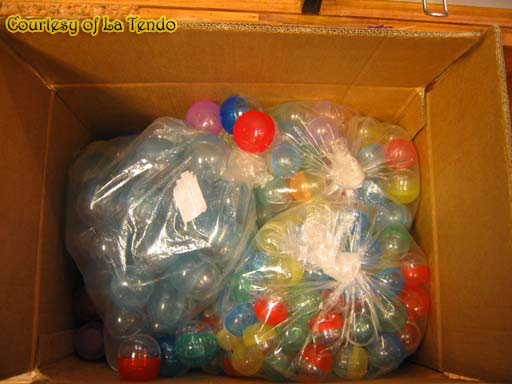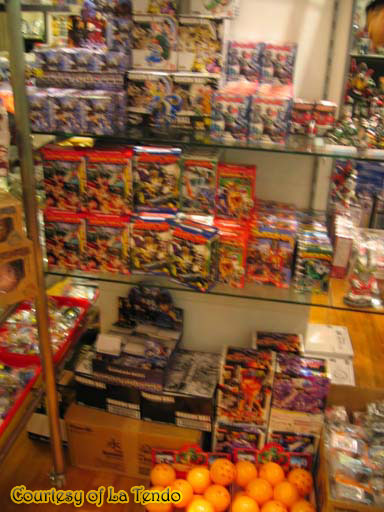|
|
|
 |
|
 |
Welcome to my Gashapons (should be Gachapon but in Singapore we called it "Gashapon") Rakuen. In English, it means a paradise for capsule toys. Before you start wondering about this new-found euphoria for such a toy genre that is sweeping the whole of Asia and even other worldwide, let me introduce to gashapons and its cousins shokugans (candy toys) and trading figures…(Just a personal insight, do correct if I'm wrong, if you guys have a much better idea about this topic.)
Gashapon was derived from the common Japanese slang, "Gachapon" which was a loose term for capsule toys. In Singapore, we affectionately known as "tikam" which derived from the Malay word for "random" I supposed. (Perhaps our Malay readers could correct me if I'm wrong there.) The word "Gachapon" refers to the sound heard while one is capturing a capsule from the machine; "Gacha" is the action when you turned the knob clockwise after putting in the coin while "Pon" would always followed as the capsule rolled down the little "mouth" at the foot of the machine. It offered us a little of surprise with each capsule rolling out as we anticipate the surprise to be a pleasant one; however you always seemed to get anything but the ideal one (much like a blind date). I remembered myself growing up so infatuated by how many different pieces I could get from a certain capsule machine, only to realize I had been spending all my pocket money on the same common piece.
The gashapon culture coincided with the anime culture which started from the late 60s - early 70s. This is when
children all over the world was engrossed by the world of Tekuya Ozamu with his Astroboy, Tatsunoko with his Gatchaman , Ultraman, Kamen
Rider, Nagai Go and his Great Mazinger and the rest of the Super Robots, Doraemon, Hayao Miyazaki with his Heidi etc.
 Gashapon was like
a channel in which children can get a piece of their favorite anime characters. The toys itself also evolved from those rubber figures to
plastic parts that are all in grid and required some assembling to coloured PVC figurines in the 21st century. However the capsules are
not just restricted to just figurines but other types of collectibles, as well such as pins, cards, rings etc. I remembered back in the
80s, machines generally came from Japan or the capsule itself is from Japan. These days "bootleg" capsule machines could be spotted at our
neighborhood heartlands which might be of the product of Malaysia, Taiwan or Hong Kong, which offered a cheap alternative for the real deal.
Nevertheless, I'm glad to see plenty of official capsule machines in most major toy stores these days.
Gashapon was like
a channel in which children can get a piece of their favorite anime characters. The toys itself also evolved from those rubber figures to
plastic parts that are all in grid and required some assembling to coloured PVC figurines in the 21st century. However the capsules are
not just restricted to just figurines but other types of collectibles, as well such as pins, cards, rings etc. I remembered back in the
80s, machines generally came from Japan or the capsule itself is from Japan. These days "bootleg" capsule machines could be spotted at our
neighborhood heartlands which might be of the product of Malaysia, Taiwan or Hong Kong, which offered a cheap alternative for the real deal.
Nevertheless, I'm glad to see plenty of official capsule machines in most major toy stores these days.
Beside capsule toys, in my website I would also cover "pick-up" toys, which
consist of boxed candy toys and trading figures.
 Candy toys (also known as shokugans) also had a history that dated back to the 70s in
which manufacturers would entice buyers with colorful, attractively designed boxes with an assortment of collectibles, however most of
the time at the expense of the quality of the candy which mostly are pretty awful-tasting even till these days. However brands like Horacio
(which specialized in making cookies), Morinaga and Fujiya have produced much tastier foodstuffs as compared to other companies. These days
bottle-caps trading figurines have also been very popular when launched together with popular drinks like Pepsi, Coca-cola etc.
Candy toys (also known as shokugans) also had a history that dated back to the 70s in
which manufacturers would entice buyers with colorful, attractively designed boxes with an assortment of collectibles, however most of
the time at the expense of the quality of the candy which mostly are pretty awful-tasting even till these days. However brands like Horacio
(which specialized in making cookies), Morinaga and Fujiya have produced much tastier foodstuffs as compared to other companies. These days
bottle-caps trading figurines have also been very popular when launched together with popular drinks like Pepsi, Coca-cola etc.
I could not account for the rise of boxed trading figures in which the manufacturers forgo the cheap tasting candies to concentrate on high quality figures. These "pick up" toys generally are more expensive due to their quality; packaging and most of the time came with some secret characters. Medicom toys' Kubrick range is a very good example of a trading toy.
R egardless the nature of the toys, all these shared the same "tikam" value. This pop culture has risen to popularity over the years and by looking at the quality they can deliver for a mere 100 to 600 yen (around S$1.60 to S$9.60), this culture is here to stay.

© Copyright KK Heng 2004